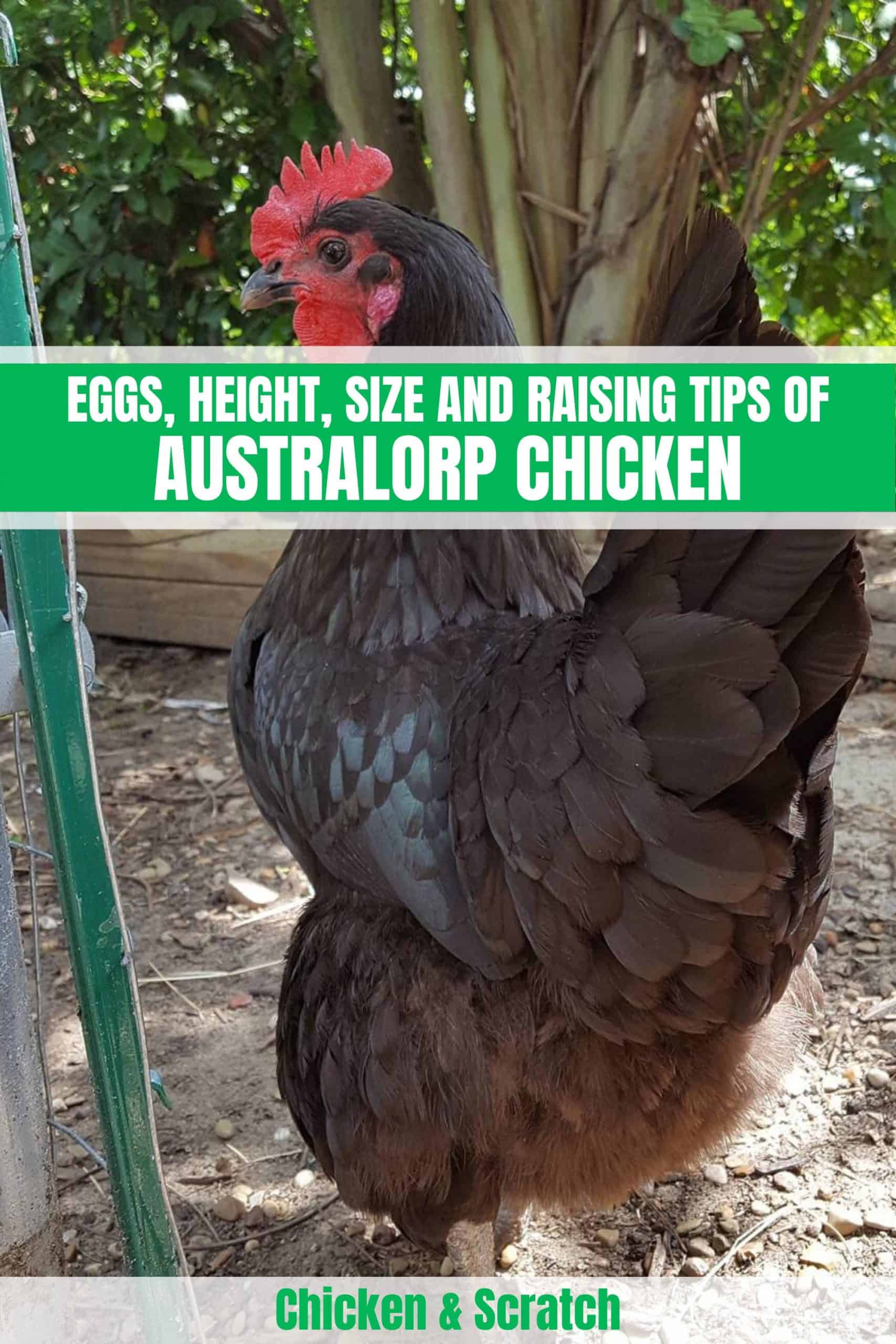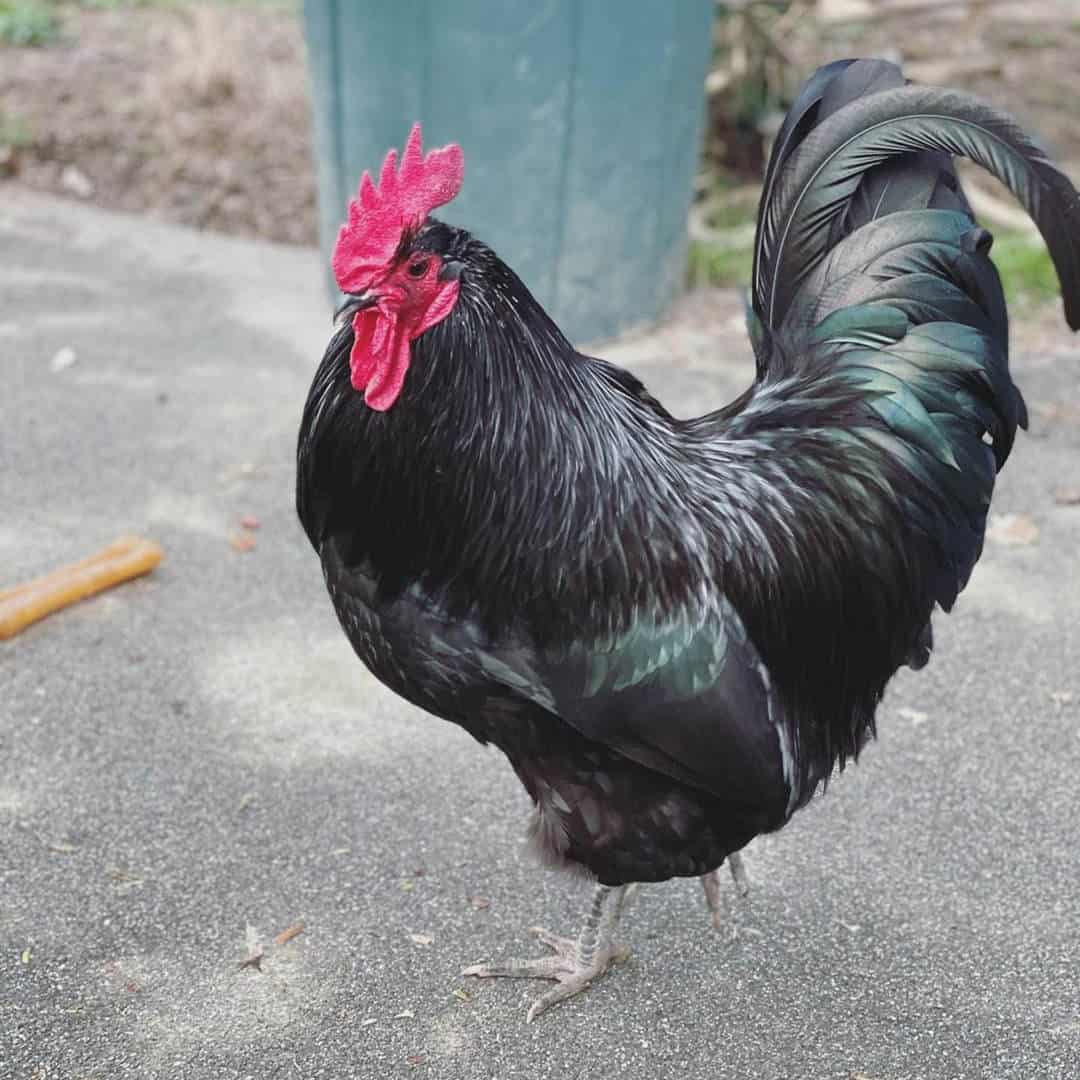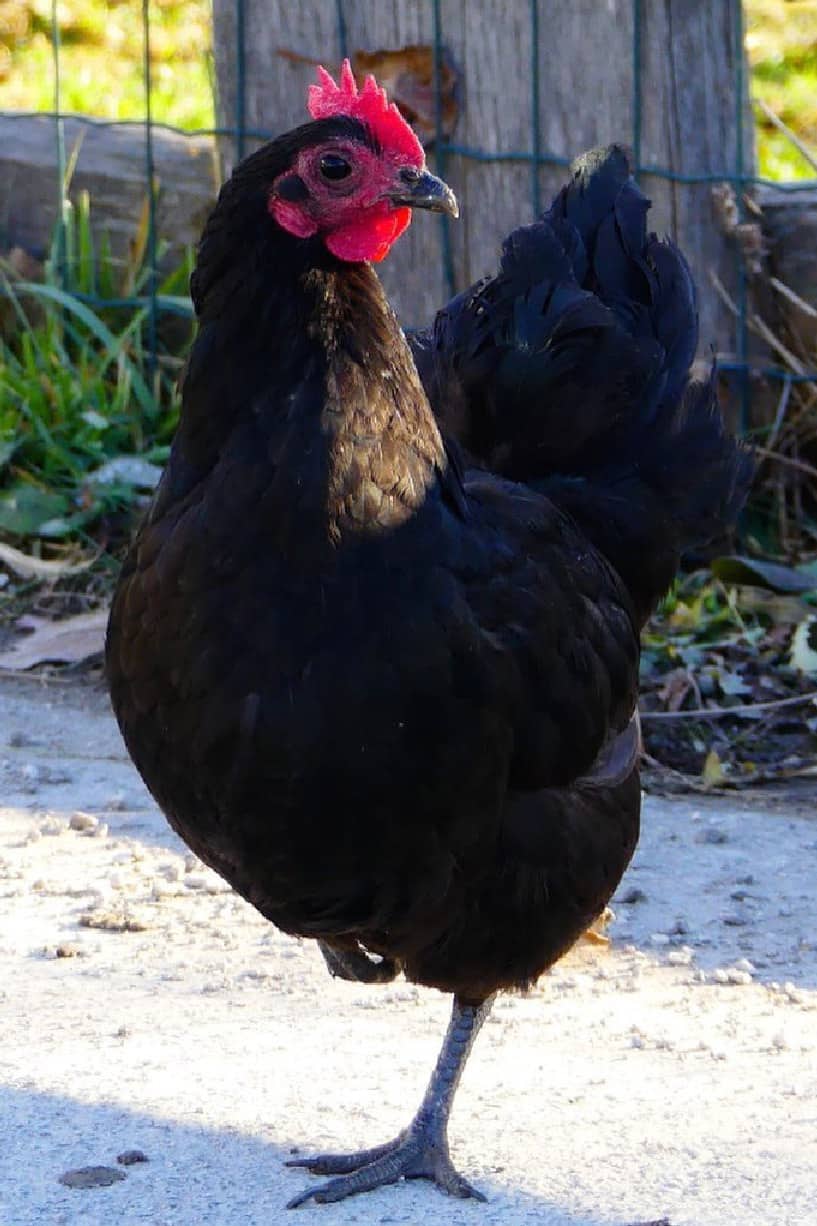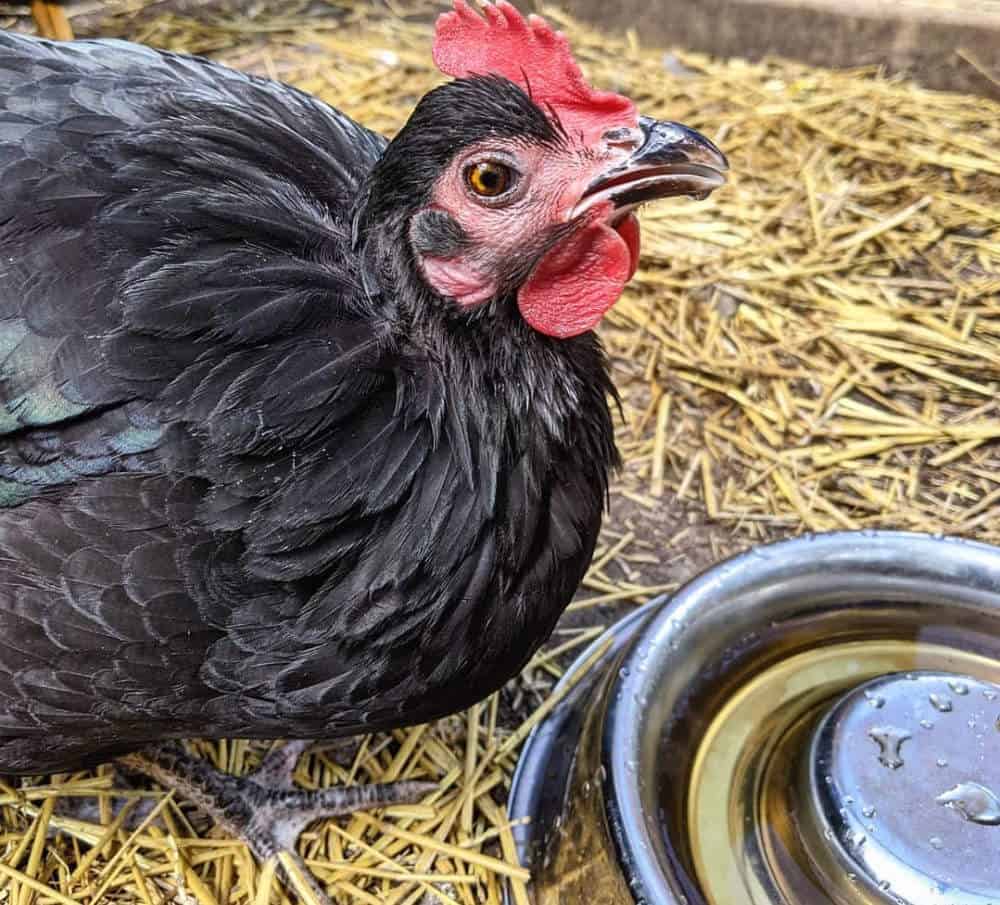The Australorp chicken is a breed that was developed in Australia. They are handsome birds, usually all black with red combs and wattles, but what really makes this breed stand out is its prolific egg-laying ability and hardiness when kept in natural, free-range conditions.

Ameraucana Chicken Overview
| Feature | Australorp Chicken |
| Purpose | Dual Purpose (Meat and Egg) |
| Egg Color | Brown |
| Egg Size | Large |
| Broodiness | Very Broody |
| Heat Tolerance | Yes |
| Cold Tolerance | Yes |
| Comb Type | Single Comb |
| Egg Production | About 250 to 300 eggs per year |
| Chicken Skin Color | Yellow |
| Life Span | 7-8 years |
| Adult Weight | Hen: 6.5-7.5 lbs, Rooster: 8.5-10 lbs |
| Backyard Friendly | 5/5 (Friendly and adaptable to smaller spaces) |
If good produce is what you are looking for, then look no further than the Australorp breed. This Australian chicken is not just perfect for laying eggs, they also produce a hefty amount of meat!
Since its conception in the late 1890s, backyard farmers and enthusiasts alike have been using this breed as an excellent starter. Especially as small farms and homestead rises, this breed is a fixture in many of them. But why though?
Except for their incredible produce, the answer lies in their excellent temperament and hardiness. Their friendly and docile nature makes them very easy to handle. This pro is a plus to many new and starting farmers.
Wherever part of the world you are, this hardy breed can be the new addition to your flock. That said, they will still need protection against harsh environments, just like any animal.
Background of Australorps

The ancestors of the Australorp were primarily black Orpingtons imported into Australia in the late 1890s. They were carefully selected to be dual-purpose chickens (meat and egg birds), and other breeds were used to improve their traits, such as Rhode Island reds, Minorcas, White Leghorns, and Langshans.
The breed achieved fame when six hens living under natural conditions produced 1857 eggs in one year, an average of 309 eggs per hen. One hen was noted to have laid 364 eggs in one year, an achievement that is rarely possible even for hens kept indoors under artificial lighting conditions.
Backyard chicken owners are currently reporting that the average free-range Australorp hen can produce up to 300 eggs per year. The average young free-range hen across all breeds only lays 200 eggs per year; in comparison, the average artificially kept young battery hen of any breed lays around 320 eggs per year but has a miserable existence and a short life span.
Due to their impressive egg-laying abilities, this breed was exported from Australia to many countries around the world starting in the 1920s and is quite popular among US backyard chicken keepers today for many reasons, including their gorgeous appearance, egg-laying abilities, and wonderful temperament.
As a heritage breed, they went through a period where the breed was considered endangered, but currently, they are categorized as recovering and are rapidly attracting attention as a chicken well worth owning.
Type of Australorp Chickens

Australorps are considered to be fairly large chickens. Full-grown hens weigh around six pounds, and roosters can reach ten pounds. Classically, they are black with a red comb and wattle, but in some countries, such as Australia, the breed standard also allows for white or blue varieties of the Australorp with a red comb and wattle.
They should have round, deep breasts and an upright stance, carrying the tail high. The comb, wattle, and earlobes should be a rich, deep red. The comb should have no more than seven points. The legs should be free of feathers and should be dark in color.
The beak and eyes should also be dark in color, and there should be four toes per foot. The sleek black feathers should have an iridescent greenish-purple shine in full sunlight.
Their eggs are light brown in color and are considered to be extremely large in size. The breed is formally classified as a heritage breed, meaning it breeds naturally, thrives under free-range conditions, and is extremely hardy and resistant to adverse environmental conditions.
Australorp Personality and Temperament
Owners of Australorps report they are generally gentle and friendly birds. Unlike some breeds of chickens that engage in fierce interchicken harassment or seem to hate people, these birds generally get along well with other chickens and seem to enjoy interacting with people.
Their owners report they will run up to them and follow them around, especially if the owner is the type that hands out treats like mealworms and berries.
The roosters of this breed are also quite well-behaved and rarely, if ever, attack humans or harass their hens; despite this, the roosters are described as being very effective protectors of their hens, keeping a keen eye on them and scanning the area for predators like hawks and foxes while the hens are foraging.
Egg Laying
Australorps, like most chickens, generally begin laying eggs when they are around five months old. After a few weeks of random egg-laying and possibly some weird misfires with malformed or shell-less eggs, the hens settle down to producing an egg almost every day.
If the chickens are provided with nesting boxes, they will generally use them for egg-laying. Australorps, unlike some chicken breeds, don’t have a tendency to hide their eggs or get angry when the eggs are collected.
After around age two, hens naturally start to gradually lay fewer eggs per week; a young bird will lay on average six to seven eggs per week, while a five-year-old bird may only lay two eggs a week.
If your birds are laying fewer than the expected number of eggs, they are probably stressed by something happening in their environment or just taking a temporary bio-break. Chickens can, if well cared for, live for up to 20 years, although most end up as soup around age 10 when they stop laying more than the occasional egg.
This breed also has a natural tendency to brood and hatch their eggs if the owner keeps a rooster around, doesn’t regularly collect their eggs, and wants a new batch of chicks. If you are raising chickens for meat, like all of the more natural heritage breeds, the Australorp breed takes much longer than “broiler” meat hybrids to reach the desired five-pound broiler weight.
Australorp Health Issues

Now, let’s get into the health issues you might encounter while caring for this breed.
Egg-laying Problems
As we established, Australorps are excellent for egg-laying purposes, but, there is a caveat. This breed is also prone to egg-laying problems.
This can come in the form of egg-binding or softer eggshells. As they lay eggs more often they are more prone to getting the egg stuck inside. Along with that, if your flock does not have enough nutrients, softer eggshells and lower-quality eggs can be a huge problem.
Other than that, there are no breed-specific health issues that exist for Australorp. Most of their disease is widely prevalent in other breeds as well.
How to take care of Australorp?

Laying hens should be fed a good, high-quality layer grain mash or pellet. While some people feel that free-range hens can do okay on lower levels of protein, we feel that a 20% protein layer formula is healthier for them. Free-range chickens will also forage for insects, worms, and even mice to supplement their diets with extra protein.
They also eagerly eat greens and weeds; if you live in a colder climate, during the winter, it is essential to supplement your chickens’ diet with fresh greens like spinach, and most chickens really enjoy a good snack of freeze-dried mealworms, shrimp, or other protein sources like soldier worm larvae.
It’s a good idea to offer a supply of extra calcium for building those strong eggshells. Most feed stores that sell chicken feed also sell calcium sources in the form of crushed oyster shells and the like. Simply put a bowl of it in the chicken coop and let the hens decide if they want extra calcium or not.
Australorps are a generally healthy, robust breed, and there are no known genetic health issues in the breed to be concerned about.
It is important to be aware that chickens are delicious, a fact well-known by a large number of predators, including raccoons, weasels, foxes, snakes, cats, and hawks. Most of these predators only go looking for chicken snacks at night.
In order to keep your backyard chickens alive, you need to provide a very secure, safe coop for them to retreat into at night for safety. Chickens can be trained to learn the routine and will return to the coop at night after foraging all day.
Tips for Raising Australorp Chickens

You have three options for obtaining chickens: buy fertile hatching eggs and an incubator to hatch them out and then brood them, buy chicks and brood them, or buy adult birds from someone local. Most backyard chicken owners opt for buying chicks from a local farm/feed store (usually the same place that they buy their chicken feed from) and brooding them.
Although hatching eggs is a fun and fascinating process, it only goes well if you spend a lot of money buying an incubator and an automatic egg-turner.
If you want to produce new chickens every year, investing in such equipment makes sense, but if you are an average backyard chicken owner who only wants to acquire one or two chicks every ten years, the investment in these devices doesn’t make much sense, versus just buying the chicks when you need them.
Young chicks have trouble controlling their body temperature. When raised by a mother hen, the mother provides warmth to the chicks. When raising chicks away from a mother hen, you’ll need to provide a source of heat in a safe environment until the chick fully fledges out, a process referred to as brooding.
The temperature in the brooder is gradually decreased over time as the chicks mature. Most farm/feed stores have heating lamps and heating devices available for sale, and it is actually possible to successfully brood a few chicks in a cardboard box supplied with a heating lamp, water, and food if you don’t want to buy or construct a dedicated brooder.
It may also be necessary to provide the chicks with medicated feed for the first few weeks to ward off disease and to supplement their water with electrolytes, vitamins, and probiotics to make sure they start off life as healthy as possible. While Australorps are generally very sturdy, robust birds, young chicks can be delicate.
Summary
In summary, the Australorp is a gorgeous, hardy, sturdy bird that thrives in a free-range environment. It was selectively bred during its development to be both a good meat bird and a very prolific egg layer. They are gentle, friendly, quiet, and peaceful and make a good addition to a mixed-breed flock or when kept as an Australorp-specific flock. They lay large light-brown eggs in abundance.

Joseph Hudson has been raising chickens for over 15 years. In 2018, he completed the Agriculture & Natural Resources program at Mt. San Antonio College. He currently raises over 1400 chickens on his 7.5-hectare farm. He keeps sharing his experience on raising healthy and happy chickens on Chicken Scratch The Foundry.







Title says, “height”. Did I miss something. If I did I’m sorry, but I didn’t see it in the text.
Roost Height: 2 to 4 feet
But, what is height of chicken?
My Astrology hens are at least 18 inches with their head up. I don’t have a rooster. I would say you need over 2 feet clearance.
Yeah! I’m looking, also. Want to build an extra run in the yard.
Would very much like to see the answer to this question. What is the typical HEIGHT OF THE BIRD (Male___ and Female_____). Need to know how much space to have between the ground and the floor of the coop so that they can shelter underneath. Thanks.
How much do baby chicks cost and does the yellow chicks cost a different price?
I paid $1.79 a piece for 2
day old Austrolop chicks at Tractor Supply in Carson City Nevada. They are less if you but straight run chicks, not sexed. I bought sexed chicks, 98% pullets, because I don’t want a rooster. I bought 4 and they are going on 5 months and are big and healthy. Can’t wait for the eggs.
Can they lay a random larger white egg?
These sound like a perfect chicken breed for me but where to buy them? I live in Oregon near salem.